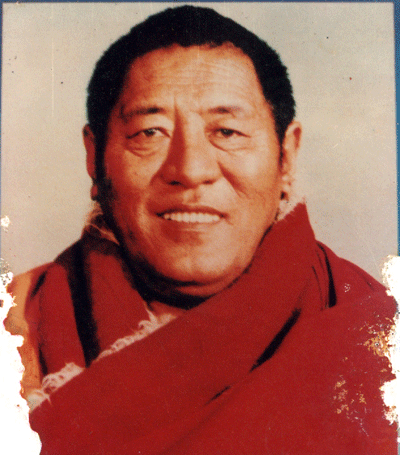Biography and autobiography in Tibet are important sources for both education and inspiration. The authors involved in the Treasury of Lives mine primary sources to provide English-language biographies of every known religious teacher from Tibet and the Himalaya, all of which are organized on their website. The following summarizes the biography of Khenpo Jigme Phuntsok, by Antonio Terrone.
 Few religious masters have had as important a role in the survival and rebirth of Buddhism in Tibet after the Cultural Revolution as Khenpo Jigme Phuntsok (1933–2004). By working within the Communist Chinese administrative system, he was able to establish and grow a monastic community, Larung Gar, that has continued to provide inspiration and support for tens of thousands of Buddhist practitioners.
Few religious masters have had as important a role in the survival and rebirth of Buddhism in Tibet after the Cultural Revolution as Khenpo Jigme Phuntsok (1933–2004). By working within the Communist Chinese administrative system, he was able to establish and grow a monastic community, Larung Gar, that has continued to provide inspiration and support for tens of thousands of Buddhist practitioners.
Khenpo Jigme Phuntsok was born to a nomadic family in the Golok region of Amdo. At the age of 5 he was identified as a reincarnation of the famous treasure revealer Lerab Lingpa, also known as Terchen Sogyel, of whom the contemporary master Sogyal Rinpoche (b. 1947) is also a recognized reincarnation. Soon after he entered Nubzur Monastery in Serta, a branch of the important Nyingma institution Pelyul Monastery, his own revelatory propensity began to manifest: he is said to have retrieved several statues and other objects before the age of 15. He went on to study with other masters in the region, including the 3rd Penor Rinpoche (1932–2009), primarily to study Dzogchen.
In 1957, at the age of 24, he was invited to assume the post of abbot, or khenpo, of Nubzur Monastery, where he continued to reveal treasure and began to open sacred places for religious practice. It was a difficult time for the Tibetans of Amdo: the assimilation of Tibetan regions into the People’s Republic of China meant that many religious activities became severely proscribed. Monasteries and practice centers were closed and demolished, and clerics and yogis were being harassed, imprisoned, and even murdered.
To avoid arrest, Khenpo Jigme Phuntsok withdrew from public life and, accompanied by a few monks, found refuge in a secluded area in the mountains around Serta. There, isolated from the violence and destruction, the small group managed to secretly continue their practice of Dzogchen meditation, and Jigme Phuntsok was able to continue to teach. Word of his accomplishments in practice, teaching, and revelation began to spread, and ultimately pamphlets, booklets, photos, posters, DVDs, Video Discs, autobiographical materials, and audio recordings of his teachings—not to mention the pins, pendants, and talismans of every kind bearing his image—circulated across the Tibetan plateau.
In the early 1980s, after the worst of the Cultural Revolution was over, Khenpo Jigme Phuntsok’s community of followers developed a mountain hermitage called Larung Gar on the same site originally founded as a mountain hermitage in 1880 by the treasure revealer Dudjom Dorje (1835–1904). Khenpo Jigme Phuntsok quickly attracted thousands of devotees. The encampment was dedicated to the study and practice of Dzogchen, as well as traditional monastic education in the Nyingma tradition. Instilled with a strict adherence to the Buddhist monastic codes, monks and nuns to this day reside in separate areas of the sprawling campus. In 1987, the 10th Paṇchen Lama (1949–1989) gave the site official endorsement, allowing it to grow into one of the most popular centers of Buddhist learning in 20th-century Tibet.
In the late 1980s, Khenpo Jigme Phuntsok began to travel, first going to the Buddhist sacred mountain of Wutai Shan, which has been a meeting place of Tibetan, Mongolian, and Chinese religions and politics for centuries. There he delivered what was perhaps the earliest post-Mao–era teaching by a Tibetan lama to Chinese Buddhists—a major event in the spread of Tibetan Buddhism in contemporary China.
In 1988, he went to Beijing to teach, and then to Lhasa. In 1990, the 14th Dalai Lama and his former teacher, Penor Rinpoche, invited him to India. After a stop in Nepal he continued on to Dharamsala, where he exchanged teachings and empowerments with lamas in the exile community. He also visited Bhutan at the invitation of Dilgo Khyentse Rinpoche. In 1993 he traveled to several Asian and Western countries including Japan, England, France, Canada, and the USA.
Somewhat unusual for a treasure revealer, Khenpo Jigme Phuntsok never returned his monastic vows and, dedicated to the revival of monasticism in Tibet, refused to perform sexual yoga with a female partner even when recommended in some of his own visions.
The fast and unrestrained growth of the site and its population has often caused concern among local government authorities. The success of Larung Gar as a major center of Buddhist learning, ethics, and cultural development attracted three waves of government crackdowns and demolitions between 2001 and 2004. Although thousands have been forced to leave, the encampment has never been officially closed. It currently houses over 10,000 practitioners of various ethnicities.
Khenpo Jigme Phuntsok passed away on January 7, 2004 at the Military Hospital 363 in Chengdu, the capital of Sichuan.
Learn more about Larung Gar Buddhist Academy in the new issue of Tricycle.
Thank you for subscribing to Tricycle! As a nonprofit, we depend on readers like you to keep Buddhist teachings and practices widely available.